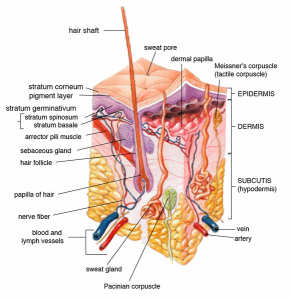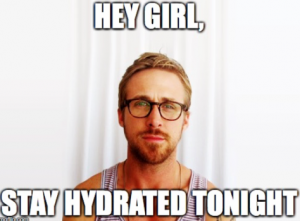“Dear pimples,
if you’re going to live on my face, I need to see some rent.
Sincerely, everyone” –Author Unknown
“Cover-up”- Author Unknown (CC0 License).
THE BACK STORY
Puberty sucks, on so many levels. Nearly every teenager has woken up in the morning and discovered a huge crater on their face. Vividly, I recall waking up with pimples spaced sporadically all over, colonizing my face like red fire ants. Many times, I would think that my acne had a mind of its own, as it refused to be concealed. No matter what creams, cover-ups and compensations were used, there they stayed, as proud as can be. Often, I would have complete strangers approaching me giving me their bogus remedies and “advice” to minimize the effects. Undoubtedly, my acne gave me celebrity status, as it made me more approachable- in the worst way possible. Luckily, those times are behind me and naturally, my pimples faded with age, so I thought- until university happened! Here I am today, a third-year student, with less prominent, but still sporadic, red fire ants “crawling” on my face! Looking around, I feel comfort in the fact that I’m not alone!
THE SCIENCE
The Canadian Dermatology Association states that acne is a multifactorial skin condition that has affected approximately 85% of peoples ranging between 12-24 years of age globally, and can occur during any stage of life. Molecular genetics have found that the infamous gram positive organism, Propionibacterium acnes, is a key player in the pathogenesis of this disease (1; Figure 1). This organism thrives under anaerobic conditions and in areas with high concentrations of sebaceous follicles, like our skin (2)! Acne can be non-inflammatory, or inflammatory and either whiteheads or blackheads can form (3). Specifically, our skin is porous and is composed of two distinct layers: the epidermis and dermis (3; Figure 2). The epidermal layer is the outermost part of our skin and is composed of five layers (3). Hair follicles and sebaceous glands are diverticula of the epidermis into the dermis and are key contributors to the pathogenesis of acne (4). Essentially, the sebaceous glands are responsible for producing an oily, triglyceride-rich substance called sebum that acts as a protective barrier which helps keep the skin and hair moisturized (4).
Figure 1. Gram positive, rod shaped Propionibacterium acnes (Wikipedia Commons, Public Domain certified).
Figure 2. Human skin anatomy, specifically illustrating the epidermis, dermis, and hypodermis layers respectively (Wikipedia Commons, The Free Media Suppository).
We’ve all been told once or twice by our peers that our blemishes can be caused by a variety of factors such as stress, lack of sleep, drinking too much coffee, hormones, chocolate, and greasy foods affecting the skins’ physiology. Specifically, when pimples form, they are still in their non-inflammatory state but when popped an inflammatory response results! Particularly, hypertrophy can be caused by hormones, leading to the overproduction of sebum from our sebaceous glands. After this, hyperkeratinization of the epithelial cells in the epidermis results in the obstruction of the sebaceous follicles, and forms a comedone (5; Figure 2). A comedone, a fancy name for pimples, is a nasty combination of oily sebum, keratinized cells, bacteria, and other fatty acids. (6). Essentially, the difference between a blackhead and a whitehead is the presence or absence of oxygen in the comedone (5). When the comedone is open and not fully obstructed, then oxygen is able to enter and form a black head (5). A blackhead forms because the sebum gets oxidized, causing the blackening of the comedone (5). The opposite is also true, except a white head will result as no oxygen is present! Comedone formation and excessive sebum production will continue, making this a very favorable environment for P.agnes proliferation (6). This bacterium thrives off of the triglycerides (TAG) found in the sebum and contains special enzymes that convert the TAG into fatty acids (6). This cycle of hypertrophy and hyperkeratinization persists until the comedone ruptures, resulting in the final stage of acne pathogenesis, inflammation and acne formation (6)! Comedone rupturing can be detrimental as it can often leave behind a nasty mark like scarring!
Watch “Acne in Motion,” or Click Here
THE DRUGS
Lucrative pharmaceutical industries are making sky-high profits at an excess of 3 billion dollars per year off of acne medication alone! Low estrogen birth controls, Accutane, and benzoyl peroxide containing creams are commonly used drugs to treat acne. The FDA states that Accutane poses to be a risk to our health as there have been serious side effects associated with this drug like suicidal ideation, Crohn’s disease, and birth defects. Antibacterial agents, like benzoyl peroxide containing creams like Benzagel, can be used to destroy and prevent the growth of P. acnes (7) and are a much safer route. The active compound, benzoyl peroxide, contains a weak O2-O2 bond (Figure 3) that easily breaks down when in contact with bacteria (7). Eventually, benzoyl radicles react with the bacteria’s proteins and kills the bacteria. This reaction produces molecular oxygen, which is detrimental for the bacteria thriving in your pimples because they can only survive under anaerobic conditions (2).
Figure 3. Chemical Structure of Benzoyl Peroxide (Public Domain).
HELP YOURSELF
Acne is inevitable, however, there are things we can do to help minimize the effects! As tempting as it sounds, popping your pimples is NOT one of them! All this does is further irritate the skin, causes redness and potential scarring (9). What we can do is stay hydrated (10)! By simply drinking water throughout the day, we are decreasing the amount of breakouts, and thus, oil being produced by our sebaceous glands. Next, touch your face less- a lot less (10)! Virtually, every surface in the world is crawling with microorganisms that are just waiting to assault your face, therefore, it is important to be cognizant about what we are touching, and washing our hands too (10)! Throwing at least seven hours of sleep into the mix also goes a long way, as it revitalizes our skin and gives it a chance to just breathe (10). Although these are all very generic recommendations I believe we often forget to take care of ourselves- I guess the moral of the story here is that a little self-help goes a long way!
“Ryan Gosling”- Author Unknown (Modified Image, CC2.0).






Recent Comments